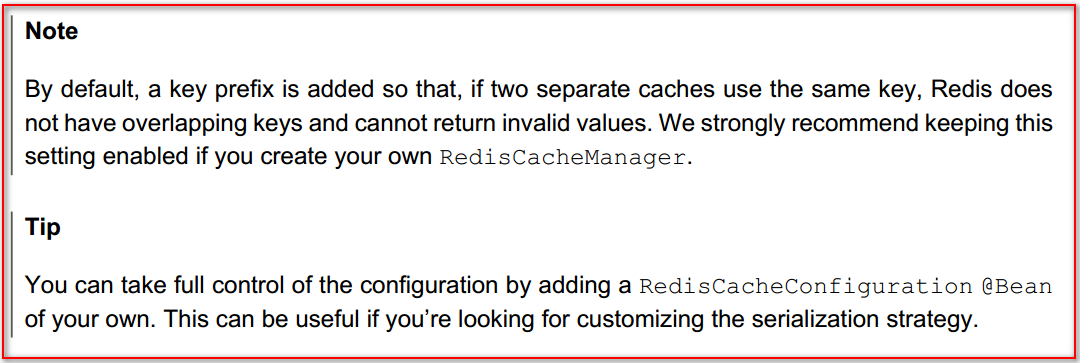Spring Boot Cache配置 序列化成JSON字符串
当我们使用@Cacheable注解的时候会将返回的对象缓存起来,我们会发现默认缓存的值是二进制的,不方便查看,为此我们自定义序列化配置,改成JSON格式的
配置如下:
pom.xml
<?xml version="1.0" encoding="UTF-8"?>
<project xmlns="http://maven.apache.org/POM/4.0.0" xmlns:xsi="http://www.w3.org/2001/XMLSchema-instance"
xsi:schemaLocation="http://maven.apache.org/POM/4.0.0 http://maven.apache.org/xsd/maven-4.0.0.xsd">
<modelVersion>4.0.0</modelVersion> <groupId>com.cjs.example</groupId>
<artifactId>cjs-springsecurity-example</artifactId>
<version>0.0.1-SNAPSHOT</version>
<packaging>jar</packaging> <name>cjs-springsecurity-example</name>
<description></description> <parent>
<groupId>org.springframework.boot</groupId>
<artifactId>spring-boot-starter-parent</artifactId>
<version>2.0.2.RELEASE</version>
<relativePath/> <!-- lookup parent from repository -->
</parent> <properties>
<project.build.sourceEncoding>UTF-8</project.build.sourceEncoding>
<project.reporting.outputEncoding>UTF-8</project.reporting.outputEncoding>
<java.version>1.8</java.version>
</properties> <dependencies>
<dependency>
<groupId>org.springframework.boot</groupId>
<artifactId>spring-boot-starter-cache</artifactId>
</dependency>
<dependency>
<groupId>org.springframework.boot</groupId>
<artifactId>spring-boot-starter-data-redis</artifactId>
</dependency>
<dependency>
<groupId>org.springframework.boot</groupId>
<artifactId>spring-boot-starter-security</artifactId>
</dependency>
<dependency>
<groupId>org.springframework.boot</groupId>
<artifactId>spring-boot-starter-thymeleaf</artifactId>
</dependency>
<dependency>
<groupId>org.springframework.boot</groupId>
<artifactId>spring-boot-starter-web</artifactId>
</dependency> <dependency>
<groupId>org.projectlombok</groupId>
<artifactId>lombok</artifactId>
<optional>true</optional>
</dependency>
<dependency>
<groupId>org.springframework.boot</groupId>
<artifactId>spring-boot-starter-test</artifactId>
<scope>test</scope>
</dependency>
<dependency>
<groupId>org.springframework.security</groupId>
<artifactId>spring-security-test</artifactId>
<scope>test</scope>
</dependency>
</dependencies> <build>
<plugins>
<plugin>
<groupId>org.springframework.boot</groupId>
<artifactId>spring-boot-maven-plugin</artifactId>
</plugin>
</plugins>
</build> </project>
application.yml
spring:
cache:
type: redis
redis:
cache-null-values: false
time-to-live: 3600000ms
redis:
host: 10.123.52.189
port:
database:
password: 自己的密码
logging:
level:
root: info
RedisConfig.java
package com.cjs.example.config; import com.fasterxml.jackson.annotation.JsonAutoDetect;
import com.fasterxml.jackson.annotation.PropertyAccessor;
import com.fasterxml.jackson.databind.ObjectMapper;
import org.springframework.beans.factory.annotation.Autowired;
import org.springframework.cache.annotation.CachingConfigurerSupport;
import org.springframework.cache.annotation.EnableCaching;
import org.springframework.context.annotation.Bean;
import org.springframework.context.annotation.Configuration;
import org.springframework.data.redis.cache.RedisCacheConfiguration;
import org.springframework.data.redis.cache.RedisCacheManager;
import org.springframework.data.redis.cache.RedisCacheWriter;
import org.springframework.data.redis.connection.RedisConnectionFactory;
import org.springframework.data.redis.core.RedisTemplate;
import org.springframework.data.redis.serializer.Jackson2JsonRedisSerializer;
import org.springframework.data.redis.serializer.RedisSerializationContext;
import org.springframework.data.redis.serializer.StringRedisSerializer; @EnableCaching
@Configuration
public class RedisConfig extends CachingConfigurerSupport { @Autowired
private RedisConnectionFactory redisConnectionFactory; @Bean
public RedisTemplate<String, Object> redisTemplate(RedisConnectionFactory redisConnectionFactory) {
Jackson2JsonRedisSerializer<Object> serializer = new Jackson2JsonRedisSerializer<Object>(Object.class);
ObjectMapper objectMapper = new ObjectMapper();
objectMapper.setVisibility(PropertyAccessor.ALL, JsonAutoDetect.Visibility.ANY);
objectMapper.enableDefaultTyping(ObjectMapper.DefaultTyping.NON_FINAL);
serializer.setObjectMapper(objectMapper); RedisTemplate<String, Object> redisTemplate = new RedisTemplate<>();
redisTemplate.setConnectionFactory(redisConnectionFactory);
redisTemplate.setKeySerializer(new StringRedisSerializer());
redisTemplate.setValueSerializer(serializer);
redisTemplate.setHashKeySerializer(new StringRedisSerializer());
redisTemplate.setHashValueSerializer(serializer);
redisTemplate.afterPropertiesSet(); return redisTemplate;
} @Bean
public RedisCacheManager redisCacheManager(RedisTemplate redisTemplate) {
RedisCacheWriter redisCacheWriter = RedisCacheWriter.nonLockingRedisCacheWriter(redisTemplate.getConnectionFactory());
RedisCacheConfiguration redisCacheConfiguration = RedisCacheConfiguration.defaultCacheConfig()
.serializeValuesWith(RedisSerializationContext.SerializationPair.fromSerializer(redisTemplate.getValueSerializer()));
return new RedisCacheManager(redisCacheWriter, redisCacheConfiguration);
} /**
* 二者选其一即可
*/ // @Bean
// public RedisCacheConfiguration redisCacheConfiguration() {
// Jackson2JsonRedisSerializer<Object> serializer = new Jackson2JsonRedisSerializer<Object>(Object.class);
// ObjectMapper objectMapper = new ObjectMapper();
// objectMapper.setVisibility(PropertyAccessor.ALL, JsonAutoDetect.Visibility.ANY);
// objectMapper.enableDefaultTyping(ObjectMapper.DefaultTyping.NON_FINAL);
// serializer.setObjectMapper(objectMapper);
// return RedisCacheConfiguration.defaultCacheConfig().serializeValuesWith(RedisSerializationContext.SerializationPair.fromSerializer(serializer));
// } }
UserServiceImpl.java
package com.cjs.example.service.impl; import com.cjs.example.dao.UserDao;
import com.cjs.example.entity.SysUser;
import com.cjs.example.service.UserService;
import org.springframework.beans.factory.annotation.Autowired;
import org.springframework.cache.annotation.Cacheable;
import org.springframework.stereotype.Service; @Service
public class UserServiceImpl implements UserService { @Autowired
private UserDao userDao; @Cacheable(cacheNames = "authority", key = "#username")
@Override
public SysUser getUserByName(String username) {
return userDao.selectByName(username);
}
}
反复看文档,一遍又一遍
最最重要的是


代码上传至https://github.com/chengjiansheng/cjs-springsecurity-example
Spring Boot Cache配置 序列化成JSON字符串的更多相关文章
- C#将对象序列化成JSON字符串
C#将对象序列化成JSON字符串 public string GetJsonString() { List<Product> products = new List<Product& ...
- 使用 EntityFramework后把一个对象序列化成json字符串引起循环引用的问题
先看一个T4模板生成的model实体类 著作权归作者所有. 商业转载请联系作者获得授权,非商业转载请注明出处. 作者:卷猫 链接:http://anneke.cn/ArticleInfo/Detial ...
- SpringMVC将表单对象序列化成Json字符串提交,以List接收
出自:http://blog.csdn.net/m0_37595732/article/details/71440853 HTML <%@ page language="java&qu ...
- .net 将List序列化成Json字符串
将List类型转化为Json,是我们平常开发时最常见的了.在使用中,有很多种方法,也可以使用. 第一种 第三方组件:Newtonsoft.Json.dll //转化成Json Newtonsoft.J ...
- 对象序列化成Json字符串 及 反序列化成对象
一. public static string JsonSerializer<T>(T t) { DataContractJsonSerializer ...
- jackson2.8.4java对象序列化成json字符串格式化时间
public class User {private int id; private Date birthday; private double money; private String name; ...
- 转:spring boot log4j2配置(使用log4j2.yml文件)---YAML 语言教程
转:spring boot log4j2配置(使用log4j2.yml文件) - CSDN博客http://blog.csdn.net/ClementAD/article/details/514988 ...
- (36)Spring Boot Cache理论篇【从零开始学Spring Boot】
Spring Boot Cache理论篇 在上一篇中我们介绍了Spring Boot集成Redis的实战例子,里面使用到了Spring Cache,那么什么是Spring Cache呢,本章将会做一个 ...
- 玩转spring boot——properties配置
前言 在以往的java开发中,程序员最怕大量的配置,是因为配置一多就不好统一管理,经常出现找不到配置的情况.而项目中,从开发测试环境到生产环境,往往需要切换不同的配置,如测试数据库连接换成生产数据库连 ...
随机推荐
- Pandas常用功能总结
1.读取.csv文件 df2 = pd.read_csv('beijingsale.csv', encoding='gb2312',index_col='id',sep='\t',header=Non ...
- HDU 2204 Eddy's 爱好 (容斥原理)
<题目链接> 题目大意: Ignatius 喜欢收集蝴蝶标本和邮票,但是Eddy的爱好很特别,他对数字比较感兴趣,他曾经一度沉迷于素数,而现在他对于一些新的特殊数比较有兴趣. 这些特殊数是 ...
- vue与avuex
现在 使用avuex做出来表格效果,但是看到源码看到需要使用vue,不得不开始学习vue 配置环境:cnpm配置过程:a:首先下载node.js然后根据https://www.cnblogs.com/ ...
- 用canal同步binlog到kafka,spark streaming消费kafka topic乱码问题
canal 1.1.1版本之后, 默认支持将canal server接收到的binlog数据直接投递到MQ, 目前默认支持的MQ系统有kafka和RocketMQ. 在投递的时候我们使用的是非压平的消 ...
- 开发中少不了的Fun -- 微信开发IOS端alert/confirm提示信息,去除网址(URL)的方法
在微信公众号开发的时候在使用[alert/confirm]弹出提示或者警告信息的时候,[alert/confirm]会将该公众号的网址显示出来,这样很不美观.所以很多时候我们会选择去除那个网址提示内容 ...
- VS 2013+ ArcGIS 10.3 AddIn 断点不断异常解决
1. http://resources.arcgis.com/en/help/arcobjects-net/conceptualhelp/index.html#/How_to_debug_add_in ...
- swust oj 1016
插入排序算法实现 1000(ms) 10000(kb) 2613 / 6080 插入排序算法实现. 输入 第一行是待排序数据元素的个数: 第二行是待排序的数据元素. 输出 一趟直接插入排序算法结果. ...
- idea远程打断点
(1)用如下方式启动jar java -Xdebug -Xrunjdwp:transport=dt_socket,address=5005,server=y,suspend=y -jar durati ...
- Linux常用服务器搭建
1.Linux常用服务器构建-ftp服务器 ftp服务器 FTP 是File Transfer Protocol(文件传输协议)的英文简称,而中文简称为“文传协议”. 用于Internet上的控制文件 ...
- 【盛派周三分享-2019.2.20】开放分享内容,本期主题:《SCF、DDD及相关架构思想讨论》
“周三分享”是盛派网络约定的每周三晚上定时举办的内部分享活动,活动主要由技术人员分享各方面的技术主题,并由所有参与者围绕主题进行讨论.除技术话题外,也可能涉及到相关的设计.财税.金融.政策等方面的延伸 ...
